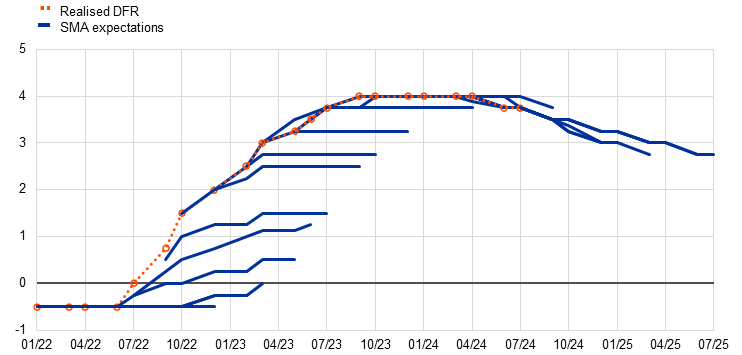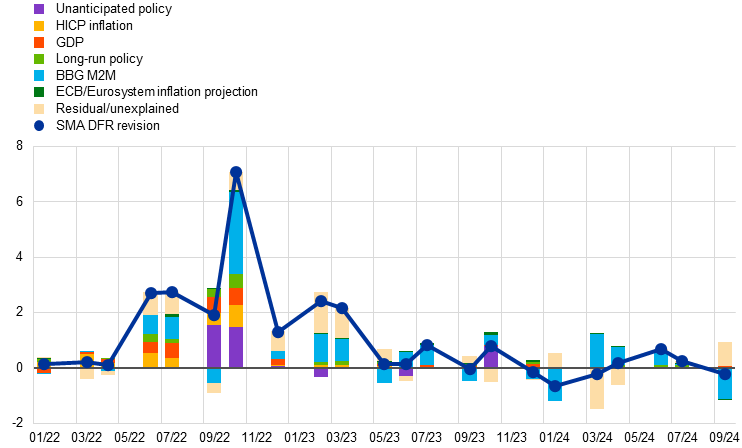Decoding revisions in policy rate expectations: insights from the Survey of Monetary Analysts
Prepared by Yıldız Akkaya and Boryana Ilieva
Published as part of the ECB Economic Bulletin, Issue 7/2024.
During the rate-hiking cycle in 2022 and 2023, financial market participants and analysts made frequent and sizeable adjustments to their expectations for ECB policy rate levels. Between July 2022 and September 2023, respondents to the Survey of Monetary Analysts (SMA) continuously revised their interest rate path expectations, with the expected peak for the deposit facility rate (DFR) being raised by 350 basis points from 0.5% to 4% (Chart A).
Chart A
SMA revisions to DFR path expectations (up to one year ahead) and the realised DFR
(percentage points)

Sources: Survey of Monetary Analysts (SMA) and ECB calculations.
Notes: The chart shows the evolution of the median SMA expectations (blue) and the DFR (red). The latest observation is for September 2024.
Understanding why SMA participants revise their expectations is important for monetary policy decision-making, as it provides insight into how changes in economic views, inflation projections, market sentiment and policy actions affect the expected policy rate path. Using the responses of individual SMA participants, revisions in the expected path of the DFR can be decomposed into several contributing factors by employing regression analysis.[1] These factors include changes in analysts’ own views about the state of the economy – in particular one-year ahead HICP inflation and GDP growth expectations – and the long-run DFR. Another factor concerns changes in the forward rate curve that are not driven by inflation and growth expectations but associated with monetary policy communication and financial market sentiment, as reflected in the Bloomberg meeting-to-meeting (BBG M2M) forward curve movements. The BBG M2M values are orthogonalised with respect to respondents’ expectations for inflation and GDP growth, thereby capturing movements beyond these expectations. A final set of factors includes differences in analysts’ expectations from the latest ECB/Eurosystem staff inflation projections and unexpected policy rate changes.[2] Together, these factors account for 50% of the variation in SMA participants’ revisions for the expected path of the DFR.[3]
The individual expectations of SMA respondents for inflation and GDP growth account for a significant share of the revisions made in the expected policy rate path (Chart B). Analysing the size of the contributions from the different factors to the DFR revisions since January 2022, revisions to HICP inflation expectations and GDP growth expectations stand out as key drivers during the surge in inflation. The prominence of changes in macro factors for DFR path revisions during this period suggests that analysts perceived a consistent monetary policy reaction function, particularly in times of heightened macroeconomic variability. In the instances when policy rate moves were not anticipated, the unexpected change is naturally reflected as a key driver of revisions of expectations.
Chart B
Decomposition of cumulative SMA revisions in DFR path expectations (up to one year ahead)
(percentage points)

Sources: Survey of Monetary Analysts (SMA) and ECB calculations.
Notes: The chart shows revisions in DFR path expectations and their decomposition since January 2022. Effect sizes are based on panel regression coefficients and the mean of individual contributing factors in each survey round. The regressors are the unexpected components of the factors that are discussed in the text. As the SMA is conducted before each Governing Council meeting, entries lag the dates of those meetings. For example, the September 2024 bar reflects differences from before and after the Governing Council meeting held in July. The latest observation is for September 2024.
The impact of financial market expectations on the DFR expectations of SMA participants plays a key role, alongside updates to their macroeconomic forecasts. A sizeable share of the revisions is consistently explained by changes in the BBG M2M forward rate curve. Forward rates, in turn, respond not just to HICP and GDP growth expectations but movements in a broader set of macroeconomic indicators, as well as the ECB’s communication. The alignment of DFR path revisions and forward rates indicates that survey participants consider a wide range of information when forming expectations. This highlights the importance of alternative, more nuanced indicators of the policy stance, particularly in the absence of explicit forward guidance on policy rates.
The evolving influence of financial market information underscores the importance of understanding and managing market expectations. While the importance of financial market information relative to macroeconomic expectations was lower during the inflation surge, the contribution of macroeconomic information on DFR expectation formation became less pronounced as of 2023. This shift occurred as the size of shocks declined significantly and expectations became more closely aligned with incoming macroeconomic information, particularly regarding headline inflation. Instead, market information started playing a dominant role as of 2023, also for the September 2023 hike. This evidence suggests that analysts adapted their policy expectations to financial market expectations, which may have been influenced by a range of factors. While financial markets respond to a broader range of macroeconomic information than is captured by the SMA, it is also important to note that ECB communication, along with macroeconomic news, does influence forward rates. Overall, the evidence illustrates the crucial role that market information plays in shaping survey expectations, particularly as SMA respondents navigate the complexities of a volatile economic landscape.
Legal Disclaimer:
EIN Presswire provides this news content "as is" without warranty of any kind. We do not accept any responsibility or liability for the accuracy, content, images, videos, licenses, completeness, legality, or reliability of the information contained in this article. If you have any complaints or copyright issues related to this article, kindly contact the author above.
